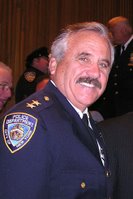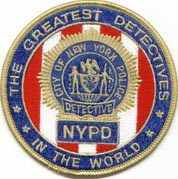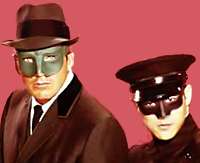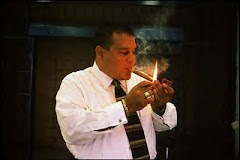 There are people in this department that work with calculators, and there are people that work with handcuffs. The problem arises when those with the calculators get in the way of those with the handcuffs.
There are people in this department that work with calculators, and there are people that work with handcuffs. The problem arises when those with the calculators get in the way of those with the handcuffs.
- From an unnamed source known to the editor.
1855 MEDAL CEREMONYSaturday, May 26, 1855.
Long before the scheduled 2 pm ceremony, a vast multitude, well over fifteen thousand of New York’s most prominent citizens gathered in City Hall Park to watch the first time ever assembly of almost the entire Municipal Police Department in uniform for a grand review and parade.
City Hall was brightly decked out with the stars and strips, city flags, along with red, white and blue banners and ribbons, all flowing lazily in a light breeze. Every window was crowded with dignitaries and vibrantly dressed ladies with colorful parasols. Even the roof was jammed with humanity. Many climbed into the trees, and almost every available branch and limb was teeming with humanity. So much so, that several of the younger tree’s tender branches gave way, abruptly dumping a spectator here and there to the ground.
In the meantime, Mayor Fernando Wood was arranging the dignitaries and elected officials for the review of the Municipal Police.
Among those present were the mayors of Jersey City and Brooklyn, many generals, most of New York’s judges, all of the police magistrates, aldermen, council members, department heads and many foreign dignitaries.
For the mayor and New York’s first Chief of Police George W. Matsell, this day would be the culmination of long planning and many months of hard work. After ten long years, the Municipal Police had finally come into its own. The department, for the first time ever, was now fully uniformed, spiffily dressed in gray pants with 1” black strips, dark blue coats and blue caps.
Moreover, many of its men had performed heroically, some making newsworthy arrests at great personal risk; others under imminent danger to themselves had performed valiant rescues. The ‘Star Police’ were now setting the standards for exemplary and meritorious service to the city.
So acting upon the recommendations of George Matsell, Mayor Fernando Wood decided that it was now time to honor the department and its heroes.
To do this, Wood and Matsell decided that there should be a grand parade and review with a ceremony to honor the finest of the ‘Stars’ for “Heroic” or “Meritorious conduct.”
Seven deserving patrolmen would be awarded silver ‘medals of merit’ at this ceremony and would be the first members of the department to be inducted into a “Legion of Honor” to be made up of the very finest that the Municipal Police Department had to offer. Six of the patrolmen would be honored for “Heroic Conduct”, and one would be honored for “Meritorious Conduct.”
To accomplish this honor, Mayor Wood, using his own personal money graciously purchased these first solid silver medals for the department.
So at the Board of Aldermen’s meeting on Wednesday, May 23, 1855, the mayor, acting on the recommendations of Chief George Matsell, introduced a resolution for the above mentioned parade, ceremony and honors. He also formally nominated the names of those first patrolmen to be awarded these medals and inducted into the ‘Legion of Honor’.
To the accompaniment of a 37-piece band and an hour behind schedule because of the huge throngs of joyous spectators cramming the park and its outlying areas, the department’s 22 ward corps, plus its reserve corps - almost the entire Municipal Police Department, over 900 men strong, proudly marched into the park, trumpets blaring and drums beating, ramrod straight and in perfect order.
Each command was led by its captain.
Just before pinning the medals on each of the patrolmen, the mayor read the accounts of each patrolman’s noteworthy deeds and Matsell pinned the medal on the patrolman’s breast.
Each of the ‘Medals of Merit’ being awarded to the patrolmen were all identical. They were all made of pure silver and were hung from a solid blue ribbon. The medal itself was in the shape of a shield, surmounted by a spread eagle, bearing a scroll inscribed with the first half of the Municipal Police Department’s motto, "Fiat justitia ruat coelum." The shield itself was decorated with stars and inscribed with the words, "New York Police."
Below the ‘New York Police’ inscription, the second element of the above aphorism, "Partum est Merito", was extolled.
Roughly translated the first Latin phrase means, “let justice be done although the heavens may fall”, expressing a commitment to do what is honorable or right regardless of the consequences. The second phrase’s literal translation is: "The duty is deserving,” expressing the thought that police duty or law enforcement in and by itself is meritorious or rewarding. Putting the two phases together, it expresses the thought, “Let justice be done, regardless of the consequences. The duty in and by itself is the reward.”
On the reverse side, the medal bore the inscription: “Presented to______ by F. Wood, Esq., Mayor, 1855 and 1856.”
As mentioned before, these valuable medals were made out of pure high grade silver and paid for by the mayor out of his own pocket.
Some of those awards included the following.
Ptl. Thomas Sampson – 18th Patrol District - “This officer has distinguished himself upon various occasions, particularly in saving life. He has saved four lives within five years. In August, 1854, he rushed into a house on fire in Seventeenth Street, near Sixth Avenue, and rescued a child, while no other man was found brave enough to undertake it. A distracted mother stood weeping and imploring some bold spirit to restore her child; all refused and skulked away, when this intrepid policeman dashed through the flames and soon placed the child in its mother’s arms. On the 16th of May last he performed another feat almost equally commendable, in rescuing the child of Mr. J.H. Anderson from death, when thrown out of that gentleman’s carriage on the Third Avenue, immediately under the wheels of a railroad car. In this effort he hazarded his own life, which was saved only by accident.”
Ptl. Swain Lindsey – 16th Patrol District – “This officer has been for a period stationed on Broadway, opposite the Museum, for the purpose of regulating the stages, (Editors Note: this means “stagecoaches”) etc., when passing that section of the street. This duty has been performed by him to the entire satisfaction of the Department; it being one for which he was peculiarly qualified. On the 28th of March last while endeavoring to stop a stage, which was proceeding at an unlawful rate, he was thrown down by the horses, and in the struggle to get up unfortunately broke his leg. He is as yet confined to his house and it will be some time before he will be enabled to resume his duties.”
Ptl Thomas N. Hoffman - Reserve Corps -“This officer’s triumphs have been of a more peaceful character. He has distinguished himself in a line of duty which, though less hazardous to personal safety has rendered substantial service. He is a well-known policeman stationed on Broadway opposite Stewart’s dry goods establishment, who has made himself exceedingly useful to the ladies crossing at that point. His attention to all, and the ceaseless vigilance he displays in the discharge of this duty, entitles him to this memento. Besides, he has been ten years a member of the Police Department without having had one charge against him.”
Ptl. Thomas Sloney – 10th Patrol District – This officer arrested, on two separate occasions, burglars with stolen property in their possession, with one of which he had a desperate fight, but succeeded in retaining his hold until assistance arrived. The officer has been recently appointed, which adds much to the affair and his devotion to his duty is additionally meritorious.”
Ptl. Thomas Sampson – 18th Patrol District - “This officer has distinguished himself upon various occasions, particularly in saving life. He has saved four lives within five years. In August, 1854, he rushed into a house on fire in Seventeenth Street, near Sixth Avenue, and rescued a child, while no other man was found brave enough to undertake it. A distracted mother stood weeping and imploring some bold spirit to restore her child; all refused and skulked away, when this intrepid policeman dashed through the flames and soon placed the child in its mother’s arms. On the 16th of May last he performed another feat almost equally commendable, in rescuing the child of Mr. J.H. Anderson from death, when thrown out of that gentleman’s carriage on the Third Avenue, immediately under the wheels of a railroad car. In this effort he hazarded his own life, which was saved only by accident.”
Ptl. Jesse C. Kinner – 3rd Patrol District – This officer performed a highly commendable feat on the morning of the 17th of February last, in which he nearly lost his life. He was on detective duty, and observed two suspicious persons before daylight on that morning, at the corner of Broadway and John Street, he watched them until satisfied they were burglars, and there with the intention of robbery. He then made an effort to arrest them both. One of them struck him with a jimmy in the jaw, cutting it severely, and the other at the same time cut him on the head with a chisel. He, however, made a desperate fight and succeeded after a long chase in capturing them both, though suffering much from loss of blood and the injuries he had received. The burglars have since been sentenced to the State prison.”
THE WORLDS MOST EXPENSIVE CIGAR
If you're a cigar aficionado and money is no object you might want to try to get your hands one some of these:
It's the world's most expensive cigar -- US$440 each and it only comes in boxes of 40 -- but is it the best? Nobody knows because no one has smoked one.
The Cuban havanas from the Cohiba brand are so precious no one has actually lit one yet.
The blend was tested by a group of tasters before the cigar went into hand-made production, says Norma Fernandez, the "torcedora" or cigar-roller from the El Laguito factory in Havana.
The cigar was launched in Spain recently by Altadis, the exclusive importer of Cuban cigars into Spain. Only 4,000 cigars were rolled.
The Cohiba "Behike" can only be bought in special humidors -- US$18,860 for the 40 cigars.
INTERESTING WEB SITEA THREE HOUR TOURhttp://tarlton.law.utexas.edu/lpop/etext/jarvis.htmThis site provides an unbelievable report on GILLIGAN’S ISLAND. If you've ever watched this show, you've got to check this out!
COOL-COP VIDEOhttp://www.veoh.com/videoDetails.html?v=e134935gZrxj524MY NOTE ABOUT LINKS FROM THIS SITEIt’s been brought to my attention that some readers have been trying to “click” on the links noted on this site in an attempt to bring themselves directly to the linked-site.
That’s certainly understandable, as that’s the way it’s done on most internet sites.
Except, for now, on this one.
You see, I’m not that good at setting up these “instant” links – sometimes it works, sometimes it doesn’t. Please bear with me as I try to get better.
In the meantime, anytime you want to “check out” a link I’ve mentioned, if simply clicking on it doesn’t do the trick, then just try the old-standby – drag the cursor over the link, and “copy” it, then in the internet address at the top of the page, “paste” it and hit “enter” – that should bring you to the link.
I’m sorry it isn’t always easier – but, hey – I just figured out how to insert a photo – and this is purely a part-time venture – I’m trying my best.
If there are any readers who can “tutor” me along these lines – how I can make it so you just have to “click” on a word and it brings you to the internet link – I’d be glad to take any assistance you could give me!
Ltjac77@yahoo.comThanks again!
“LEST WE FORGET…” THE NYPD MEMORIALNovember 9, 1849 Ptl William Helms, 10Dist (7Pct), Bldg collapse (MunicPD)
November 9, 1970 Sgt Henry Tustin, 32 Pct, Shot-robbery
November 10, 1919 Ptl John McCormack, 38 Pct, Shot-DV dispute
November 11, 1989 PO Gary Coe, BSTF, Stabbed, off duty incident
November 11, 1992 PO Milagros Johnson, 109 Pct, Shot – off duty robbery
November 12, 1922 Ptl Charles Hoffman, 3 Pct, Line of duty injury
November 12, 1986 PO Kenton Britt, Hwy3, Auto accident on patrol
November 13, 1968 Ptl Joseph Pignataro, 46 Pct, Auto accident on patrol
November 13, 1989 Det Richard Guerzon, QDAS, Shot by prisoner
November 14, 1907 Ptl Edward Kavanagh, 47 Pct, Shot, robbery pursuit
November 15, 1930 Ptl William Vorden, Traffic C, LOD heart attack
November 17, 1849 Ptl William Helms, NFI
November 17, 1929 Ptl John Duffy, 23 Pct, Shot – Robbery in progress
November 17, 1945 Ptl Francis McKeon, 34 Pct, Shot by EDP
November 18, 1961 Ptl Charles Gunther, 105 Pct, Motorcycle accident on patrol
November 19, 1926 Ptl Edward Byrns, 45 Pct, Shot-pursuit
November 20, 1980 PO James Dunston, PSA5, Shot-Burglary arrest
November 22, 1857 Ptl Horatio Sanger, 9 Pct, Head injury
November 22, 1930 Ptl William Senk, Mcy2, Motorcycle accident
November 23, 1938 Ptl Clarence Clark, 105 Pct, Auto Accident
Ptl. Victor Cooper, 105 Pct, Auto Accident
November 23, 1989 Det Keith Williams, QDAOS, Shot by prisoner
November 24, 1939 Ptl Michael Lonto, 75 Pct, Auto accident on patrol
November 24, 1971 Ptl Patrick O’Connor, ESU, Auto accident
November 24, 2004 PO William Rivera, 78 Pct, LOD injury
November 25, 1933 Ptl Peter Costa, 3Div, Shot-robbery in progress
November 25, 1946 Lt Charles Michie, ESU, Explosion-Rescue
Ptl Peter Kundsen, ESU, Explosion-Rescue
Ptl Francis O’Hara, 102 Pct, Explosion-Rescue
November 25, 1904 Ptl James Devens, 66 Pct, Trampled by horse
November 27, 1963 Det Ronald Rolker, 18 Sq, Shot-robbery, off duty
November 28, 2005 PO Dillon Stewart, 70 Pct, Arrest
November 29, 1941 Ptl. James Collins, 62 Pct, Line of duty heart attack
November 30, 1900 Ptl William Baumeister, 29 Pct, Shot- assault arrest
November 30, 1957 Ptl Joseph Rauchut, Mcy2, Motorcycle accident on patrol








